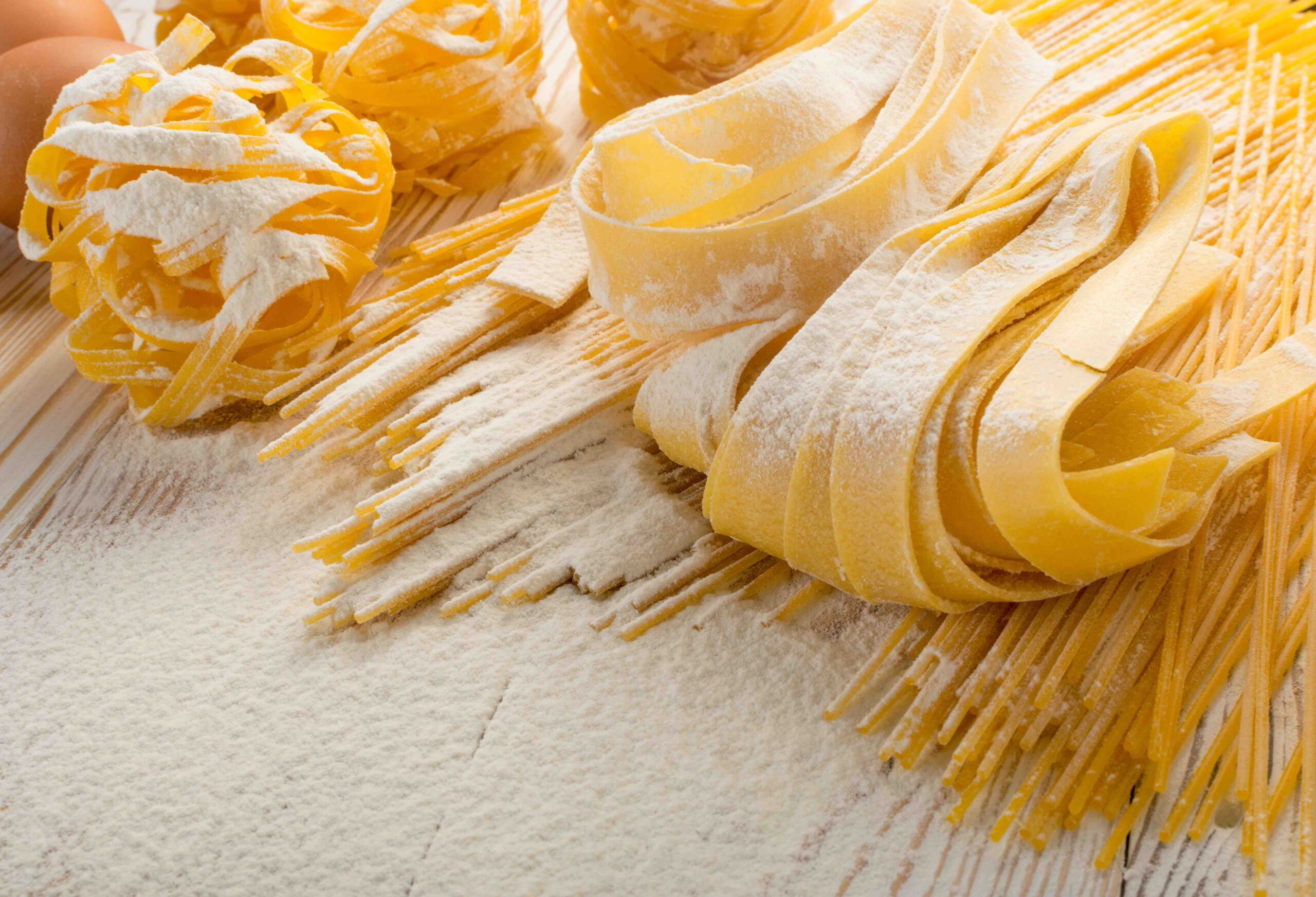Spaghetti is a type of pasta that everyone knows. But did you know that there is also a flat version of spaghetti? And not just one, but several different kinds! There are a whole bunch of flat pasta types you’ve probably never heard of. That’s why we’ve listed them all.
What is the name of flat spaghetti?
There are many different types of flat “spaghetti. For example, you have long, flat pasta shapes called linguine, fettuccine, tagliatelle or pappardelle. In short, the name of flat spaghetti is difficult to describe because there are several varieties, each with its own name. The kind that looks most like flat spaghetti is called linguine.
Because it can be difficult to tell all those flat, oblong pastas apart, we have listed all the types. Just so you know!
The difference between flat pasta and spaghetti
Spaghetti is a type of pasta that everyone knows and you will certainly have eaten it at some point. If we look at spaghetti we see an elongated pasta type that is round in shape. This makes it easy to wrap around pasta sauce and makes this pasta ideal for many pasta dishes. Spaghetti is so popular because you can use the long pasta in many pasta dishes.
Flat pastas are often angular and have a wider surface area. The advantage to flat pasta is that sauce sticks well to the surface because, simply put, there is more surface area. This ensures that the pasta and sauce become one, extra delicious if you ask us!
So the big difference between spaghetti and other oblong flat pasta types is that spaghetti is round, and the other types are flat.
Different types of pasta flat pasta
Flat pasta is often also elongated. Flat, oblong pasta types are also called ribbon pastas. We’ll go over them all with you so you can learn about the different types of ribbon pastas.
Linguine
Linguine is a narrow, ribbon-shaped pasta, which makes it most similar to flat spaghetti. Flat spaghetti is therefore also called linguine. The pasta is not completely flat so it has an oval shape. Because of the shape it is more difficult to make this type of pasta fresh than other ribbon-shaped pastas.
This pasta shape is very popular in Italy. In Italy, they often use linguine in famous pasta recipes such as pasta bolognese.
Tagliatelle
Tagliatelle is, in our opinion, the most photogenic type of pasta there is. This is the reason why you often see this type in commercials, for example. Tagliatelle originally comes from Bologna, the capital of the Emilia-Romagna region.
Fettuccine
Fettuccine literally means “little ribbons” in Italian. The pasta owes this name to its shape. Fettuccine is a very easy pasta that you can use in a lot of dishes. It is the little brother of the tagliatelle. Just as long, but a little thinner. There are many different types of fettuccine. For example, there are varieties with funghi, basil and spelt.
Pappardelle
Papperdelle is the widest type of pasta of all the ribbon-shaped pastas. The wide pasta is suitable for hearty sauces with meat. By using pappardelle you put a real statement dish on the table. For papperdelle it is customary to cook the pasta ‘al dente’. The best way to do this is to read on.
Tonnarelli
Tonnarelli looks like a flat spaghetti. The difference is that tonnarelli has a square shape. In Italy this type of pasta is used in the popular pasta dish cacio e pepe. Besides this dish, tonnarelli is delicious in all kinds of pasta dishes. We recommend combining it with creamy sauces.
Ingredients of flat pasta
Like most pasta, flat pasta is made from durum wheat and water. With flat pasta, it is also common to incorporate egg into the dough. This makes the pasta extra creamy, but it has even more advantages. The egg makes the pasta extra nutritious so you are satiated for longer.
Besides egg, other ingredients are sometimes added to the dough to give the pasta a particular flavor. Examples are: linguine with squid ink, fettuccine with spinach and fettuccine with peppers.
In short: because of the different ingredients, there are all kinds of flat pasta available. Above all, choose the pasta that suits your taste and the dish you want to make. You can vary endlessly!
How is flat pasta made?
The ingredients we mentioned above play the biggest role in the production process of flat pasta. These ingredients are kneaded together into a beautiful pasta dough.
This pasta dough then goes through a bronze mold. This creates the desired shape of the pasta, in this case that of ribbon pasta. After that, the pasta only has to dry and then be packaged.
Of course, making pasta is a lot more elaborate and involves a lot more than what we have described now. In order not to make this blog too long, we wrote a whole blog about making pasta. You can read all about it in the blog: “How is pasta made?”.
Cooking flat pasta
Now you have become a little wiser when it comes to long flat pasta. In addition to recognizing the different types, it is important that you know how to cook these types of pasta.
With our tips, it will be a piece of cake! On average, long flat pasta types often require more than 10 minutes to cook. Therefore, it’s important that you have plenty of time.
Fortunately, there are ways to cook pasta even faster. Use these if you are short on time. If not, you can of course take it easy. In our blog How to cook pasta quickly, we give you useful tips on how to cook pasta faster.
Below we have explained in a number of steps how to cook the pasta. You will see that you can cook the pasta just right if you follow these steps.
Flat pasta is cooked in 6 steps:
Use a large saucepan to cook the flat pasta
Take a large saucepan, the larger the better. The flat pasta must be able to move around in the pan. This prevents the flat pasta from sticking together. Fill the large pan with 75% hot water. By using hot water you save time because the water does not need as long to boil. Do you want to save a lot of time? Then use a kettle so the water is already boiling.
Add some salt to the water
Make the pasta dish tastier by adding a little extra salt to the boiling water. The salt makes sure it gives flavors in a dish an extra boost. This makes all the flavors more intense and delicious! Be careful, because too much salt can ruin your dish. We keep a guideline of about 10 grams of salt per 3 liters of water. You can read more about cooking pasta and salt in our blog: ‘Cooking pasta with or without salt’.
Do not use a lid when cooking flat pasta
By not using a lid, the cooking water will not foam. For this reason, we always recommend not using a lid. This also makes it easier to keep the pasta moving. Read more about this in our next tip.
Keep the flat pasta moving
Like any pasta, flat pasta has a tendency to stick together. By keeping the pasta moving you can prevent this from happening. Stir every minute with a spaghetti spoon in the pan. In this way you keep the flat pasta moving sufficiently.
Taste the pasta before draining
If you want to know whether the flat pasta is good, it is wise to taste the cencioni. You do this before draining the pasta, so you can determine whether it is necessary to cook it longer. In addition, you immediately taste whether you have put enough salt in water. You can choose to add some more salt to taste.
Add the flat pasta to the pasta sauce at once
In Italy, they always add the pasta to the pasta sauce right away. This makes it less likely that the flat pasta will stick together. By doing this you will never have problems with sticky pasta. This is a good tip that we would like to pass on to you.
How long should you cook flat pasta?
The answer to this question depends on which flat pasta you want to cook. Fettuccine cook faster than pappardelle, for example. We recommend always looking carefully at the packaging of the pasta to find out the exact cooking time. If you stick to this, you will see that the pasta is cooked just right.
Some people like their pasta to have more bite. If you like that, it is best to cook pasta ‘al dente’. Al dente literally means al dente and means that you don’t cook the pasta thoroughly enough to eat it.
Do you want to cook pasta ‘al dente’? Then subtract a minute or so from the cooking time. Taste for yourself when you think the pasta is cooked enough. You can read more tips on how to do this in our blog: ‘How to cook pasta al dente!
How much flat pasta do you need per person?
It can be tricky to determine the amount of flat pasta you need. It mainly depends on the type of dish you want to make with it.
Are you opting for a hearty, well-filled sauce? Then use a little less flat pasta. If you are using a lighter sauce, from olive oil for example, you can use a little more.
In general, we use about 100 grams of pasta per person. If you are someone who eats a lot or a little, you can of course adjust the number of grams.
In addition, always look carefully at the type of sauce you combine the pasta with. Do you opt for a hearty, well-filled sauce? Then use a little less pasta, 80 grams per person.
Determining the right amount of pasta for each person can be tricky. If you also find it difficult to determine the amount of pasta you need, read more about the quantities on our blog: “How much pasta do you cook per person?
Recipes for flat pasta
The advantage of long, flat pasta is that you can combine it with all kinds of pasta sauces. It is delicious with well-filled meat sauces, but you can also use it in light sauces.
The flat surface of the pasta allows the sauce to stick well to the flat pasta. The long strands curl around the ingredients making the dish a whole. In our opinion, this is a very big advantage!
Flat pasta can be combined with all kinds of dishes. We recommend tasting and trying them to find out what you like best.

